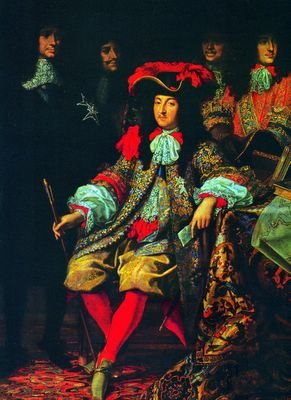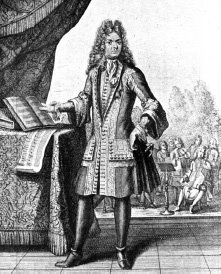The French Clavecin School and the Creation of the Dance Suite
A parallel situation arose in early seventeenth-century
The lutenists tended to play stray movements as a unit. The harpsichord composers who followed, beginning around 1640 and called the French clavecin school, were more careful to unify their suites. "Clavecin" is the French name for harpsichord. The term suite comes from the French verb suivre, to follow. The name likely came into use by the custom of writing "suite" at the end of a dance to indicate that the next dance in the manuscript or book should follow.
As the dances were formally arranged by the clavecinists, all the dances shared a single key, each component dance featured a different meter, rhythmic characteristic, tempo, and affect, or emotional element. The clavecinists were centered at the court of Louis XIV in

Louis XIV
Notable members included its founder Jacques Champion de Chambonnierres, Louis Couperin, Jean-Henri d'Anglebert, Nicolas-Antoine Lebegue, Jean-Philippe Rameau, and Francois Couperin, Louis Couperin's nephew.
<>Jean-Baptiste Lully, though not a harpischordist but a guitarist, must also be included as a member of the school. Lully was the most powerful musician a the court of Louis XIV. He was a talented guitarist and dancer but, first and foremost, he was an innovative composer of dance and operatic music. In

Jean Baptiste Lully
The suite proper required a minimum of an allemande, a courante, and a sarabande. The most serious movement was the allemande, and in it the French lute composers came closest to art music. The term allemande means "German" or German dance. The allemande was a moderate tempo dance cast in duple meter that assumed a serious, often majestic character. The serious character of the movement and its high level of musical sophistication later cast it as the prototype from which the Classic Period sonata-allegro would derive.
The courante, or corrente in Italian, derived its character from the French verb courir, to run. The name more accurately describes the Italian version because Italian musicians preferred even-note running lines. In French hands, the courante assumed the character of frequent metric shift. The movement was always written on compound meter, that is, with a number of beats in each measure that could be interpreted as either duple or triple meter. Hence six beats may be divided by accent into two groups of three or three groups of two. The shift may be demonstrated by counting aloud evenly 1 2 3 1 2 3 1 2 1 2 1 2 or 1 2 1 2 1 2 1 2 3 1 2 3.
The sarabande has the most curious history of all the suite movements. It originated in the New World, likely
As noted, other dances promoted by Lully were included in clavecin suites by the second half of the seventh century. The gigue, which followed a metric scheme defined by four groups of three even notes that could be counted for effect:
1 2 3 1 2 3 1 2 3 1 2 3
1 ----2-----3----4-----
The gigue was a lively dances that originated in the
The gigue became a permanent feature of the suites written by northern composers by accident. Johann Jakob Froberger (1616-1667), a keyboard composer whose publications served to disseminate French innovations to
French provincial additions of Lully included the country-dances the gavotte, the bouree, the minuet, the passpied, the loure, and the rigaudon, among others. These dances were placed in the order after the nuclear dances. The gigue usually stood midpoint between the sarabande and the provincial dances. The French suite followed the pattern:
In the suites of northern composers such as J.S. Bach, the gigue was placed at the end and the additional dances were inserted between it and the sarabande. The minuet is the only suite movement to survive intact into the repertory of the Classic period. The German suite followed the pattern:
dances, inserted before gigue in typical order, Gavotte and Bouree-Gigue
Dancing consumed a considerable portion of life at the Sun King's court. The suites for lute and clavecin were intended for listening rather than dancing, but the same movements as found in the suites for solo instruments, when played by orchestra, were clearly intended for dancing. To that end, dance masters were employed to develop choreography for professionals dancing in the opera-ballets, but also to teach members of the nobility the dance steps proper to each movement. The written instructions and manuscripts by the dance masters are essential to conscientious modern performers in understanding how each dance should be played.

<< Home